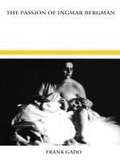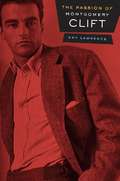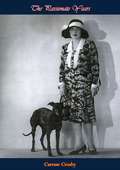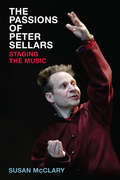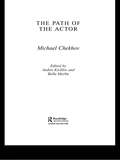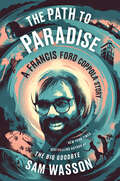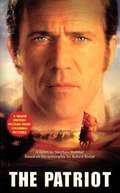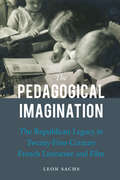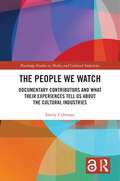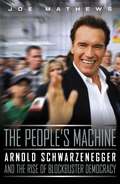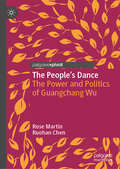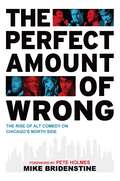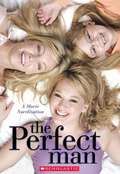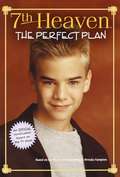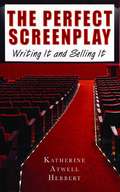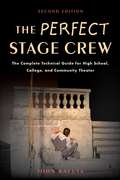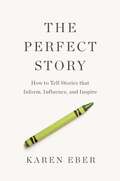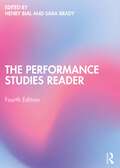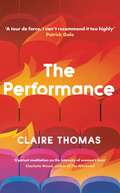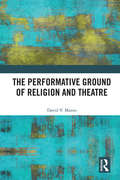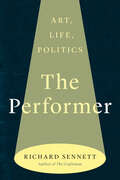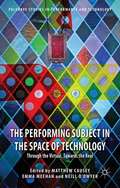- Table View
- List View
The Passion of Ingmar Bergman
by Frank GadoAcknowledged as one of the greatest filmmakers of this or any other time, Bergman has with few exceptions written his own screenplays--an uncommon practice in the film industry--and for this practice critics refer to him as a "literary" filmmaker: In this work, Gado examines virtually the entire range of Bergman's literary output. While treating the matter of the visual presentation of Bergman's films, Gado concentrates on story and narrative and their relationship to Bergman's personal history.Gado concludes that whatever the outward appearance of Bergman's works, they contain an elementary psychic fantasy that links them all, revealing an artist who hoped to be a dramatist, "the new Strindberg," and who saw the camera as an extension of his pen.
The Passion of Montgomery Clift
by Amy LawrenceChallenging the myth of Clift, actor, as tragic victim, Amy Lawrence explores the way Clift's extraordinary looks, controversial sexuality, and the accident that allegedly changed the course of his career continue to feed the religious intensity of fan discourse.
The Passionate Years
by Caresse CrosbyA mad, amusing, and revealing look at Paris in the twenties and at the people Caresse Crosby knew—Hemingway, F. Scott Fitzgerald, Edith Wharton, James Joyce, Picasso, Ezra Pound, T. S. Eliot, Lawrence of Arabia, and a host of others. In a single day, a visitor to the Crosby home outside of Paris might have found Salvador Dali at work in one room, Douglas Fairbanks Senior playfully swinging from the rafters, and D. H. Lawrence sunning himself by the pool.“In her autobiography Mrs. Crosby has added a valuable footnote to the literary history of our time....She tells some amazingly good stories. Her account of Lindbergh’s arrival in Paris is a superb piece of straight reporting and her description of a Quatre Arts ball at which she won first prize for reasons that cannot be mentioned in a family newspaper is funny and sad at the same time. Her fostering of unknown or otherwise unpublishable writers (Crane, Joyce, D. H. Lawrence, among others) through the Black Sun Press can now be seen clearly for the important project it was.—The New York Times“The Passionate Years becomes immediately an essential document of its era. Also it is an entertaining book.”—New York Herald Tribune
The Passions of Peter Sellars: Staging the Music
by Susan McClaryRecognized as one of the most innovative and influential directors of our time, Peter Sellars has produced acclaimed—and often controversial—versions of many beloved operas and oratorios. He has also collaborated with several composers, including John C. Adams and Kaija Saariaho, to create challenging new operas. The Passions of Peter Sellars follows the development of his style, beginning with his interpretations of the Mozart-Da Ponte operas, proceeding to works for which he assembled the libretti and even the music, and concluding with his celebrated stagings of Bach’s passions with the Berlin Philharmonic. Many directors leave the musical aspects of opera entirely to the singers and conductor. Sellars, however, immerses himself in the score, and has created a distinctive visual vocabulary to embody musical gesture on stage, drawing on the energies of the music as he shapes characters, ensemble interaction, and large-scale dramatic trajectories. As a leading scholar of gender and music, and the history of opera, Susan McClary is ideally positioned to illuminate Sellars’s goal to address both the social tensions embodied in these operas as well as the spiritual dimensions of operatic performance. McClary considers Sellars’s productions of Mozart’s Le nozze di Figaro, Don Giovanni, and Così fan tutte; Handel’s Theodora; Messiaen’s Saint François d’Assise; John C. Adams’s Nixon in China, The Death of Klinghoffer, El Niño, and Doctor Atomic; Kaija Saariaho’s L’amour de loin, La Passion de Simone, and Only the Sound Remains; Purcell’s The Indian Queen; and Bach’s passions of Saint Matthew and Saint John. Approaching Sellars’s theatrical strategies from a musicological perspective, McClary blends insights from theater, film, and literary scholarship to explore the work of one of the most brilliant living interpreters of opera.
The Path Of The Actor
by Michael ChekhovThis is the first English translation of Michael Chekhov’s two-volume autobiography, combining The Path of the Actor (1927) and extensive extracts from his later volume Life and Encounters. Full of illuminating anecdotes and insightful observations involving prominent characters from the MAT and the European theatre of the early twentieth century, Chekhov takes us through events in his acting career and personal life, from his childhood in St. Petersburg until his emigration to Latvia and Lithuania in the early 1930s. Accompanying Chekhov's witty, penetrating, and immensely touching accounts are extensive and authoritative notes compiled by leading Russian Chekhov scholar, Andrei Kirillov. Anglo-Russian trained actor Bella Merlin provides a useful hands-on overview of how the contemporary practitioner might utilise and develop Chekhov's ideas. Chekhov was arguably one of the greatest actors of the twentieth century. His life made a huge impact on his profession, and his actor-training techniques inspired many a Hollywood legend – including such actors as Anthony Hopkins and Jack Nicholson -while his books outlining his teaching methods and philosophy of acting are still bestsellers today The Path of the Actor is an extraordinary document which allows us unprecedented access into the life, times, mind and soul of a truly extraordinary man.
The Path to Paradise: A Francis Ford Coppola Story
by Sam Wasson“Sam Wasson’s supremely entertaining book tracks the ups and downs, ins and outs, of a remarkable career. . . . A marvel of unshowy reportage.”—New York TimesThe New York Times bestselling author of Fifth Avenue, 5 A.M. and The Big Goodbye returns with the definitive account of Academy Award–winning director Francis Ford Coppola’s decades-long dream to reinvent American filmmaking, if not the entire world, through his production company, American Zoetrope.Francis Ford Coppola is one of the great American dreamers, and his most magnificent dream is American Zoetrope, the production company he founded in San Francisco years before his gargantuan success, when he was only thirty. Through Zoetrope’s experimental, communal utopia, Coppola attempted to reimagine the entire pursuit of moviemaking. Now, more than fifty years later, despite myriad setbacks, the visionary filmmaker’s dream persists, most notably in the production of his decades-in-the-making film and the culmination of his utopian ideals, Megalopolis.As Wasson makes clear, the story of Zoetrope is also the story of Coppola’s wife, Eleanor Coppola, and their children, and of personal lives inseparable from artistic passion. It is a story that charts the divergent paths of Coppola and his cofounder and onetime apprentice, George Lucas, and of their very different visions of art and commerce. And it is a story inextricably bound up in the making of one of the greatest quixotic masterpieces ever attempted, Apocalypse Now, and in what Coppola found in the jungles of the Philippines when he walked the razor’s edge. That story, already the stuff of legend, has never fully been told, until this extraordinary book.
The Patriot
by Stephen Molstad Robert RodatIn Britain's American colonies, the cry goes out for freedom as the air from Lexington to the Carolinas burns hot with powder smoke and cannon fire. But Benjamin Martin has had his fill of war. A veteran of the fierce French and Indian conflict, he has renounced fighting forever, retiring to his South Carolina farm to raise his motherless children in peace. Now the war has found his hiding place, bringing its senseless cruelty back into his life and destroying what he holds most dear. And Benjamin Martin must take up arms to fight again--to lead a makeshift army of brave farmers and craftsmen against a relentless, overwhelming enemy--in the blessed cause of liberty. . . and blood vengeance.
The Pedagogical Imagination: The Republican Legacy in Twenty-First-Century French Literature and Film
by Leon SachsFrench school debates of recent years, which are simultaneously debates about the French Republic’s identity and values, have generated a spate of internationally successful literature and film on the topic of education. While mainstream media and scholarly essays tend to treat these works as faithful representations of classroom reality, The Pedagogical Imagination takes a different approach. In this study of French education and republicanism as represented in twenty-first-century French literature and film, Leon Sachs shifts our attention from “what” literature and film say about education to “how” they say it. He argues that the most important literary and filmic treatments of French education in recent years—the works of Agnès Varda, Érik Orsenna, Abdellatif Kechiche, François Bégaudeau—do more than merely depict the present-day school crisis. They explore questions of education through experiments with form.The Pedagogical Imagination shows how such techniques engage present-day readers and viewers in acts of interpretation that reproduce pedagogical principles of active, experiential learning—principles at the core of late nineteenth-century educational reform that became vehicles for the diffusion of republican ideology.
The Penguin Atlas of North American History to 1870
by Colin McevedyThis is a reference to the major developments of North American history from pre-human settlement to the American Civil War and more recent changes. Maps and commentary look at
The People We Watch: Documentary Contributors and What Their Experiences Tell Us About the Cultural Industries (Routledge Studies in Media and Cultural Industries)
by Emily ColemanThe People We Watch explores the politics of contemporary media production from the point of view of the ordinary people it represents.Based upon a series of in-depth interviews and the author’s own professional experience of working in the television industry, this book examines how documentary contributors feel about participating in the media and the ways they are portrayed, considering how their experiences take shape within the structural context of the cultural industries.This insightful text will interest scholars, students, and researchers in media and communication, sociology of the media, documentary studies, and film studies, as well as those studying the cultural industries, media production, creative labour, and cultural policy.The Open Access version of this book, available at www.taylorfrancis.com, has been made available under a Creative Commons Attribution-Non Commercial-No Derivatives (CC-BY-NC-ND) 4.0 International license.Any third party material in this book is not included in the OA Creative Commons license, unless indicated otherwise in a credit line to the material. Please direct any permissions enquiries to the original rightsholder.This work was supported by the Arts and Humanities Research Council [grant number AH/L503848/1]; and the Economic and Social Research Council [grant number ES/Y007808/1].
The People's Machine: Arnold Schwarzenegger and the Rise of Blockbuster Democracy
by Joe MathewsCalifornia voters passed Proposition 13 in 1978. At the same time, a champion bodybuilder named Arnold Schwarzenegger was becoming a movie star. Over the past quarter century, the twin arts of direct democracy (through ballot initiatives designed to push the public to the polls on election day) and blockbuster moviemaking (through movies designed to push the public to the theaters on opening weekend) grew up together, at home in California. With the state's recall election in 2003, direct democracy and blockbuster movies officially merged. The result: Governor Arnold Schwarzenegger. In The People's Machine, political reporter Joe Mathews, who covered Schwarzenegger's gubernatorial campaign for the Los Angeles Times and who has subsequently broken many front page stories about him, traces the roots of both movie and political populism, how Schwarzenegger used these twin forces to win election and, especially, how he has used them to govern. "Let the people decide," said Governor Schwarzenegger after his inauguration. The People's Machine, through remarkable access and whip-smart analysis-there is news in this book-reports on whether this system of governing proves blessing, curse, or mess, and on the remarkable Austrian bodybuilder, movie star, and political man with the nerve to carry it out.
The People’s Dance: The Power and Politics of Guangchang Wu (Critical Studies in Dance Leadership and Inclusion)
by Rose Martin Ruohan ChenThis book presents an analysis of how the grassroots movement of Guangchang Wu or ‘square dance’ in China has become a national phenomenon. Through oral narratives offering rich descriptions of lived encounters, the experiences of those involved in leading, organizing, teaching and learning Guangchang Wu are revealed. Through these narratives, this book serves to understand the leadership practices occurring and how this dance practice is deeply rooted in the complexities of China’s rapid economic development, acceleration of urbanisation, and the desire for a healthier and more communal lifestyle.
The Perfect Amount of Wrong: The Rise of Alt Comedy on Chicago's North Side (The History Press)
by Mike BridenstineIn just over a decade, a tiny, do-it-yourself stand-up scene on the North Side of Chicago produced some of the most successful and influential stand-up comedians of their generation. Hannibal Buress, T.J. Miller, Kyle Kinane, Cameron Esposito, Pete Holmes, Beth Stelling, Matt Braunger and Kumail Nanjiani make up a partial list of names of comics who emerged from a scene that had very little industry attention--or even a home club. It was also a scene that took a backseat to the city's vaunted improv institution, and if we're being completely honest, it was a scene where comics mostly performed to drunks in the backs of dingy bars on their off nights. None of it was glamorous. None of it should have worked at all. But somehow, some way, the comedians from this scene have managed to etch their own names into the Chicago comedy pantheon. The Perfect Amount of Wrong is the story of that scene, as told by its veterans.
The Perfect Man
by Jenny MarkasThe perfect plan for the perfect man . . . Teenager Holly Hamilton is tired of moving every time her single mom, Jean, has another personal meltdown, involving yet another second-rate guy. To distract her mother from her latest bad match, Holly conceives the perfect plan for the perfect man-an imaginary secret admirer who will romance her mom and boost her shaky self-esteem. But when the virtual relationship takes off, Holly finds herself having to produce the suitor, borrowing her friend's charming and handsome uncle Ben as the face behind the e-mails, notes, and gifts. As time passes, Holly must resort to increasingly desperate measures to keep the ruse alive and protect her mom's newfound happiness. But will her dedication to the hoax cause her to miss the real perfect man when he does come along?
The Perfect Plan (7th Heaven)
by Amanda ChristieLucy and Mary are definitely up to something, but the rest of the family is so busy they don't seem to notice--except for sharp-eyed Simon, who's got a big surprise in store for his older sisters!
The Perfect Screenplay: Writing It and Selling It
by Katherine HerbertThey say in L.A. everybody is writing a screenplay. With The Perfect Screenplay, everybody everywhere will be writing well-presented, saleable screenplays. Packed with tips from an insider on how Hollywood operates, testing script ideas, building structure, and marketing the final screenplay, this book is the key to getting work read and sold. A resource list gives Web sites, agents, and more. Writers will be thanking the little people-and The Perfect Screenplay. Written by a top Hollywood script analyst From computer screen to silver screen in clear, easy-to-follow steps
The Perfect Stage Crew: The Complete Technical Guide for High School, College, and Community Theater
by John KalutaHere is a must-have book for anyone producing a stage show without a Broadway-sized budget. Written by a technical theater veteran, The Perfect Stage Crew explains the pitfalls to avoid and provides solutions to the most common-and the most complex-stage performance problems, even for theaters with a lack of resources. An invaluable guide for middle and high school theaters, college theaters, and community theaters, The Perfect Stage Crew teaches readers how to:Stock, organize, and store the essential backstage suppliesConceptualize, design, and build setsManage a stage crew effectivelyPaint scenery and backdropsTest, design, and hang lightingOperate and repair sound equipmentSet cuesPromote your showThis expanded second edition covers up-to-date technology, including for use with recording, sound, and lighting. Chapters also cover such crucial topics as running technical rehearsals, gathering props, and creating and selling tickets. Theater groups that need to learn the nuts and bolts of putting a show together will discover how to turn backstage workers into The Perfect Stage Crew.Allworth Press, an imprint of Skyhorse Publishing, publishes a broad range of books on the visual and performing arts, with emphasis on the business of art. Our titles cover subjects such as graphic design, theater, branding, fine art, photography, interior design, writing, acting, film, how to start careers, business and legal forms, business practices, and more. While we don't aspire to publish a New York Times bestseller or a national bestseller, we are deeply committed to quality books that help creative professionals succeed and thrive. We often publish in areas overlooked by other publishers and welcome the author whose expertise can help our audience of readers.
The Perfect Story: How to Tell Stories that Inform, Influence, and Inspire
by Karen Eber"Come for the engrossing content, and stay for the lessons that might just change how you talk, write, and lead.&” —Adam GrantLearn how to take any story and make it perfect—from storytelling expert Karen Eber, whose popular TED Talk on the subject continues to be a source of inspiration for millions.What makes a story perfect? How do you tell the perfect story for any occasion?We live in a story world. Stories are a memorable and engaging way to differentiate yourself, build connection and trust, create new thinking, bring meaning to data, and even influence decision-making. But how do you turn a good story into a great story that informs, influences, and inspires?In The Perfect Story, Karen Eber—leadership consultant, professional keynote storyteller, and TED speaker—shares the science of storytelling to teach you to:Leverage the Five Factory Settings of the Brain to hack the art of storytellingBuild a toolkit of endless story ideasDefine the audience for your storyApply a memorable story structureEngage senses and emotionsTell stories with dataAvoid common storytelling mistakesUse your body to tell dynamic storiesEnsure your story doesn't manipulateNavigate and embrace the vulnerability of storytellingWithout relying on complicated models or one-size-fits-all prescriptions, this book makes storytelling accessible with practical and impactful steps for anyone to tell the perfect story for any occasion.Through interview vignettes, The Perfect Story also shares approaches from different storytellers, including the Sundance Institute cofounder, an executive producer of The Moth, the former creative director at Pixar, the TED Radio Hour podcast host, and many more.Whether you are leading a team, giving a presentation, hosting a podcast, selling a product or service, interviewing for a job, or giving a toast at a wedding, The Perfect Story will help you take your stories and make them perfect.
The Performance Studies Reader
by Sara Brady Henry BialSince its first publication in 2004, The Performance Studies Reader has become the leading anthology of key writings on performance studies. Now in its fourth edition, it continues to offer an unparalleled selection of work by the foremost scholars in this continually evolving field, offering a stimulating introduction to the crucial debates of Performance Studies. These critical and theoretical contributions are joined in this edition by 26 new chapters, bringing the collection up to date with current discourse and ideas, and significantly expanding the range of subjects and authors represented. Each essay includes contextual headnotes from the editors, to introduce students to the writer and their impact on the field. Newly added to this edition are contributions from Swati Arora; Sara Ahmed; Sarah Bay-Cheng; Claire Bishop; Felipe Cervera, Theron Schmidt, and Hannah Schwadron; Anita E. Cherian and Gargi Bharadwaj; Thomas F. DeFrantz/SLIPPAGE; Soyica Diggs Colbert; Tracy C. Davis; Saidiya V. Hartman; Travis Jackson; Branislav Jakovljević; Ailton Krenak; André Lepecki; Fred Moten; José Esteban Muñoz; Tavia Nyong'o; Tamara Searle; Stephanie Nohelani Teves; and McKenzie Wark.This new edition of The Performance Studies Reader provides an overview of the full range of performance theory for undergraduates at all levels, and beginning graduate students in Performance Studies, theatre, performing arts, and cultural studies.
The Performance of Nationalism
by Jisha MenonImagine the patriotic camaraderie of national day parades. How crucial is performance for the sustenance of the nation? The Performance of Nationalism considers the formation of the Indian and Pakistani nation, in the wake of the most violent chapter of its history: the partition of the subcontinent. In the process, Jisha Menon offers a fresh analysis of nationalism from the perspective of performance. Menon recuperates the manifold valences of "mimesis" as aesthetic representation, as the constitution of a community of witnesses, and as the mimetic relationality that underlies the encounter between India and Pakistan. The particular performances considered here range from Wagah border ceremonies, to the partition theatre of Asghar Wajahat, Kirti Jain, M. K. Raina, and the cinema of Ritwik Ghatak and M. S. Sathyu. By pointing to the tropes of twins, doubles, and doppelgangers that suffuse these performances, this study troubles the idea of two insular, autonomous nation-states of India and Pakistan. In the process, Menon recovers mimetic modes of thinking that unsettle the reified categories of identity politics.
The Performance: A Novel
by Claire Thomas'Quietly transformational'The Times 'A tour de force... I can't recommend this too highly'Patrick Gale'Innovative... an original, at-a-sitting read'Daily Mail'A potent meditation on the intensity of women's lives'Charlotte Wood, author of The Weekend'A miracle... Engaging and evocative'Washington Post'I loved and admired The Performance... Unmissable'Emma Stonex, author of The Lamplighters'Lively and intimate... The way Thomas plays with the reader is a sort of genius'Guardian'Thomas writes these women with such wisdom and compassion, that by the end we are all transformed'Claire Fuller, author of Unsettled Ground The false cold of the theatre makes it hard to imagine the heavy wind outside in the real world, the ash air pressing onto the city from the nearby hills where bushfires are taking hold.The house lights lower.The auditorium feels hopeful in the darkness.As bushfires rage outside the city, three women watch a performance of a Beckett play.Margot is a successful professor, preoccupied by her fraught relationship with her ailing husband. Ivy is a philanthropist with a troubled past, distracted by the snoring man beside her. Summer is a young theatre usher, anxious about the safety of her girlfriend in the fire zone.As the performance unfolds, so does each woman's story. By the time the curtain falls, they will all have a new understanding of the world beyond the stage.
The Performative Ground of Religion and Theatre
by David V. MasonReligious practitioners and theatregoers have much in common. So much, in fact, that we can say that religion is often a theatrical phenomenon, and that theatre can be a religious experience. By examining the phenomenology of religion, we can in turn develop a better understanding of the phenomenology of theatre. That is to say, religion can show us the ways in which theatre is not fake. This study explores the overlap of religion and theatre, especially in the crucial area of experience and personal identity. Reconsidering ideas from ancient Greece, premodern India, modern Europe, and the recent century, it argues that religious adherents and theatre audiences are largely, themselves, the mechanisms of their experiences. By examining the development of the philosophy of theatre alongside theories of religious action, this book shows how we need to adjust our views of both. Featuring attention to influential notions from Plato and Aristotle, from the Natyashastra, from Schleiermacher to Sartre, Bourdieu, and Butler, and considering contemporary theories of performance and ritual, this is vital reading for any scholar in religious studies, theatre and performance studies, theology, or philosophy.
The Performer: Art, Life, Politics
by Richard SennettAn acclaimed sociologist&’s exploration of the connections among performances in life, art, and politics In The Performer, Richard Sennett explores the relations between performing in art (particularly music), politics, and everyday experience. It focuses on the bodily and physical dimensions of performing, rather than on words. Sennett is particularly attuned to the ways in which the rituals of ordinary life are performances. The book draws on history and sociology, and more personally on the author&’s early career as a professional cellist, as well as on his later work as a city planner and social thinker. It traces the evolution of performing spaces in the city; the emergence of actors, musicians, and dancers as independent artists; the inequality between performer and spectator; the uneasy relations between artistic creation and social and religious ritual; the uses and abuses of acting by politicians. The Janus-faced art of performing is both destructive and civilizing.
The Performing Artist's Handbook
by Janice PapolosThe right ways to handle all of the nonmusical essentials of your career, the practical know-how you need to progress in your professional music career.
The Performing Subject in the Space of Technology
by Matthew CauseyNow that the shock of the virtual has subsided toward a 'new-normal' of computational interference in all areas of life, it is an advantageous moment to reflect on the passage through the virtual and back to the real. Digital culture has developed into a bio-virtual environment in which the categories of the biological and the virtual no longer stand as separate. The contributors to this volume respond to the questions raised by the 'after-event' of the digital through practice-led researchanalyses of performance processes, philosophical readings of the work of art and technology, and performance studies investigations of the subject in the spaces of technology. The volume examines a wide range of activities, from bio-art to internet child pornography, gaming and social networking technologies to the use of motion-tracking in developing choreography and documentation. The authors draw from diverse perspectives in dance, theatre, performance, film and music studies, digital arts and culture.
